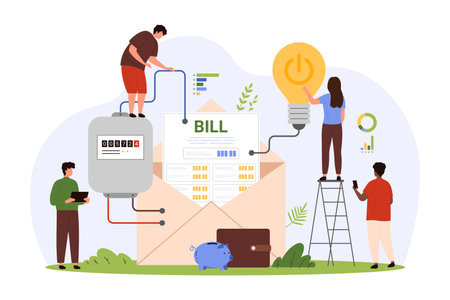Understanding Self-Employment Tax Basics
If you’re self-employed in the United States, understanding your tax responsibilities is critical for both compliance and saving money. Unlike traditional employees, the self-employed are responsible for paying the full 15.3% Social Security and Medicare tax—commonly known as self-employment tax—on their net earnings. This obligation covers both the employer and employee portions of these taxes, making the tax bill feel a lot steeper. However, this doesn’t mean you’re stuck with a hefty liability every year. The IRS offers a range of tax breaks specifically designed to reduce your overall burden. Familiarizing yourself with these opportunities can lead to significant savings come tax time. In this article, we’ll go beyond the well-known home office deduction to explore additional strategies that can help lower your taxable income and keep more of your hard-earned money in your pocket.
Health Insurance Premium Deductions
If you’re self-employed, health insurance can feel like a major financial burden. However, the IRS offers a significant tax break: the self-employed health insurance deduction. This deduction allows you to deduct premiums paid for medical, dental, and qualified long-term care insurance for yourself, your spouse, dependents, and children under age 27—even if they aren’t listed as dependents on your tax return.
Who Qualifies?
You can claim this deduction if you report income from self-employment and aren’t eligible to participate in an employer-subsidized health plan (either through your own or your spouse’s employer). The deduction is available whether you itemize or take the standard deduction, as it’s considered an “above-the-line” adjustment to income.
What Can You Deduct?
The deduction covers premiums paid for:
| Eligible Coverage | Who is Covered |
|---|---|
| Medical insurance | You, spouse, dependents, children under 27 |
| Dental insurance | You, spouse, dependents, children under 27 |
| Long-term care insurance | You, spouse, dependents, children under 27 |
Strategic Tips
To maximize your benefit: Keep detailed records of every premium payment. Remember that your total deduction can’t exceed the net profit from your self-employment activities. If your business operates at a loss for the year, you won’t be able to claim this particular deduction but may still be able to include premiums as an itemized medical expense (subject to the 7.5% AGI threshold).
Why It Matters
This deduction lowers your adjusted gross income (AGI), which can open up eligibility for other tax credits and deductions. For many self-employed individuals and freelancers in the U.S., this is one of the most valuable ways to reduce taxable income—putting more money back into your pocket while ensuring health security for you and your family.

3. Retirement Plans and Contributions
When you’re self-employed, planning for retirement is both a smart financial move and a powerful way to lower your taxable income. Unlike traditional employees who rely on employer-sponsored plans, self-employed individuals can tap into several tax-advantaged retirement savings options designed with flexibility and higher contribution limits in mind. Three of the most popular plans in the U.S. are the SEP IRA, Solo 401(k), and SIMPLE IRA.
SEP IRA: Simplicity and High Limits
The Simplified Employee Pension (SEP) IRA stands out for its straightforward setup and generous contribution limits. For 2024, you can contribute up to 25% of your net earnings from self-employment, up to $66,000. Contributions are tax-deductible, reducing your taxable income for the year. SEP IRAs are particularly appealing if you have variable income or want the option to skip contributions in leaner years.
Solo 401(k): Maximum Flexibility
If you’re a one-person business or only employ your spouse, the Solo 401(k) offers even more flexibility. You can contribute both as the employee and employer: up to $22,500 as an employee ($30,000 if age 50 or older), plus up to 25% of your net business earnings as the employer, capped at $66,000 total for 2024. These contributions are tax-deductible, and Roth options allow for after-tax savings with future tax-free growth.
SIMPLE IRA: Great for Small Teams
The Savings Incentive Match Plan for Employees (SIMPLE) IRA is ideal for small businesses with up to 100 employees. It’s easy to administer and allows for employee salary deferrals up to $15,500 in 2024 ($19,000 if age 50+). Employers must make either matching or fixed contributions—both of which are deductible on your business taxes.
Strategic Planning for Tax Savings
Choosing the right retirement plan depends on your annual income, business structure, and whether you have employees. By leveraging these accounts, you not only secure your future but also enjoy immediate tax breaks—helping you keep more of what you earn while building long-term wealth.
4. Startup and Operating Expenses
When youre self-employed, maximizing your tax breaks goes far beyond just the home office deduction. One of the most effective ways to reduce your taxable income is by strategically deducting startup and operating expenses. The IRS allows you to write off a significant portion of the costs incurred before and during the launch of your business, as well as many ongoing operational expenses. Heres how you can leverage these deductions for maximum benefit.
Startup Costs: The Initial Investment
The IRS lets you deduct up to $5,000 in qualified startup costs in your first year of business, with the remainder amortized over 15 years if your total startup costs are $50,000 or less. Startup expenses include market research, advertising before launch, travel related to securing suppliers or customers, legal fees for setting up your business structure, and other necessary costs incurred before you open your doors.
| Startup Expense Category | Examples | Deductible Amount |
|---|---|---|
| Market Research | Surveys, focus groups | Up to $5,000 (first year) |
| Legal & Professional Fees | Incorporation, consulting | Up to $5,000 (first year) |
| Advertising & Promotion | Branding, website launch | Up to $5,000 (first year) |
| Travel & Training | Conferences, client visits | Up to $5,000 (first year) |
Equipment Purchases: Section 179 Deduction
If you buy equipment or machinery for your business—think computers, printers, office furniture—you may qualify for a Section 179 deduction. This allows you to immediately expense up to $1,160,000 (for tax year 2023) rather than depreciating it over several years. This is a powerful tool for self-employed professionals who want to offset substantial investments in their operations.
Example: Equipment Deduction Calculation
| Equipment Type | Total Cost ($) | Section 179 Deduction Allowed ($) | Annual Depreciation (if not expensed) ($) |
|---|---|---|---|
| Laptop & Software Suite | $3,500 | $3,500 (100%) | $700/year (over 5 years) |
| Office Printer/Copier | $1,200 | $1,200 (100%) | $240/year (over 5 years) |
| Standing Desk & Chair Set | $900 | $900 (100%) | $180/year (over 5 years) |
Ongoing Operating Expenses: Keeping Your Business Running Smoothly
The everyday costs of running your business—from internet service and phone bills to rent and professional subscriptions—are fully deductible against your self-employment income. Here are some common operational expenses that often get overlooked:
- Utilities: Electricity, water/sewer for dedicated office space outside the home.
- Insurance Premiums: Liability insurance or errors and omissions coverage.
- Salaries and Contract Labor: Payments made to employees or freelancers assisting your business.
- Dues and Subscriptions: Industry memberships and trade publications.
The key is meticulous recordkeeping. Save receipts and keep detailed logs—these small steps add up at tax time and can mean thousands in deductions each year.
Pro Tip: Don’t forget about “soft launch” costs!
If you started spending money on your business before officially launching—maybe months of planning or networking—those are often deductible too. Consult a tax advisor familiar with U.S. self-employment rules to make sure youre capturing every possible deduction.
This proactive approach ensures that every dollar invested in your entrepreneurial journey works harder for you when it comes time to file taxes.
5. Qualified Business Income Deduction (QBI)
Understanding the QBI Deduction
One of the most significant tax breaks for self-employed Americans introduced by the Tax Cuts and Jobs Act (TCJA) is the Qualified Business Income (QBI) deduction. This provision allows eligible self-employed individuals, freelancers, and owners of pass-through entities like sole proprietorships, partnerships, LLCs, and S corporations to deduct up to 20% of their qualified business income on their federal taxes.
Who Qualifies for the QBI Deduction?
To take advantage of this deduction, your business income must come from a pass-through entity, meaning that the profits are reported on your personal tax return rather than being taxed at the corporate level. Most small business owners and independent contractors fit into this category. However, there are limitations if your income exceeds certain thresholds or if you’re in a “specified service trade or business” such as health, law, accounting, or consulting.
Income Limits and Phase-Outs
For 2024, the QBI deduction begins to phase out for single filers with taxable income above $191,950 and joint filers above $383,900. Once you exceed these limits, additional calculations apply—such as wage and qualified property caps—and some service-based businesses may lose eligibility altogether. If your income falls below these thresholds, you generally get the full 20% deduction with minimal complications.
Maximizing Your Deduction
To maximize your QBI deduction:
- Keep detailed records of all business income and expenses.
- Consider how retirement plan contributions or health insurance premiums could lower your taxable income and help keep you under the phase-out threshold.
- If you’re close to the limit, work with a tax professional to time income and deductions strategically.
Why This Matters for Self-Employed Individuals
The QBI deduction can make a substantial difference in lowering your effective tax rate. For example, if your business earns $100,000 in qualified income, you may be able to deduct $20,000 before calculating your federal tax bill. That’s real savings that can be reinvested in your business or used to build personal wealth.
Action Steps
If you haven’t already reviewed your eligibility for the QBI deduction, now’s the time. Review IRS Form 8995 or 8995-A and consider consulting a CPA who understands self-employment tax rules. With strategic planning, this deduction can be a cornerstone of your tax-saving strategy well beyond the home office write-off.
6. Vehicle and Travel Expenses
When youre self-employed, your vehicle can be more than just a way to get from point A to point B—it can also be a valuable tax-saving tool. The IRS allows you to deduct certain vehicle and travel expenses that are directly related to your business operations. However, accurately tracking these expenses and understanding the differences between personal and business use is crucial to maximizing your tax breaks while staying compliant.
Tracking Deductible Mileage
The simplest method for most self-employed individuals is the standard mileage rate, which changes annually. For every mile driven for business purposes, you can deduct a fixed amount set by the IRS. To leverage this deduction, keep a meticulous log of your business miles using a notebook, spreadsheet, or a mileage-tracking app. Your log should include the date, destination, purpose of the trip, and the number of miles driven. Remember, commuting from home to your regular workplace isn’t deductible; only trips made for business tasks—like meeting clients or purchasing supplies—count.
Business Trips
Beyond local travel, trips taken overnight or outside your usual work area may qualify as business travel expenses. Eligible deductions include airfare, hotels, rental cars, meals (usually at 50%), and even tips. Keep detailed receipts and document the business purpose of each expense. If your trip combines business with pleasure, you must clearly differentiate which costs are attributable to each. Only the business-related portion can be deducted.
Differentiating Personal and Business Use
This is where many self-employed individuals make costly mistakes. If you use your vehicle for both personal and business reasons, you can only deduct the percentage used for business. Calculate this by dividing your business miles by total annual miles driven. For example, if 60% of your mileage is for work, you can write off 60% of eligible vehicle expenses (if using actual costs instead of the standard mileage rate). Accurate records not only maximize deductions but also protect you during an IRS audit.
By keeping precise records and understanding how to separate personal from professional use, self-employed taxpayers can take full advantage of these vehicle and travel tax breaks—putting more money back in their pockets at tax time.
7. Professional Services and Education
For self-employed individuals, investing in professional services and ongoing education is not only a strategic move for business growth but also a valuable tax-saving opportunity. The IRS allows you to write off fees paid for legal, accounting, and consulting services that are directly related to operating your business. This includes everything from hiring a CPA to handle your tax filings, to seeking advice from a business attorney, or even engaging a consultant for specific projects. As long as these expenses are ordinary and necessary for your trade or profession, they can be deducted on your Schedule C.
Additionally, the costs associated with professional development—such as attending industry conferences, enrolling in workshops, subscribing to relevant publications, or taking courses to improve skills pertinent to your current business—are generally deductible. The key is that the education must maintain or enhance your existing skills, rather than qualify you for an entirely new line of work. For example, if you’re a freelance graphic designer, taking advanced design software courses or attending marketing seminars would likely qualify as deductible expenses.
Don’t overlook membership dues for professional organizations or fees for certifications required in your field; these too can reduce your taxable income. To maximize these deductions, it’s essential to keep detailed records: save invoices, receipts, course descriptions, and proof of payment. By leveraging deductions for professional services and continuous education, self-employed Americans can not only stay competitive but also lighten their tax burden each year.

